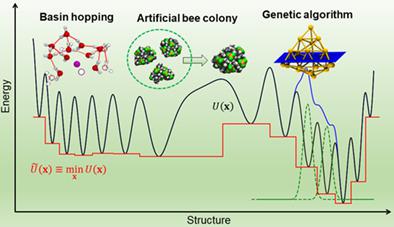当前位置:
X-MOL 学术
›
Int. J. Quantum Chem.
›
论文详情
Our official English website, www.x-mol.net, welcomes your feedback! (Note: you will need to create a separate account there.)
Global optimization of chemical cluster structures: Methods, applications, and challenges
International Journal of Quantum Chemistry ( IF 2.2 ) Pub Date : 2020-11-21 , DOI: 10.1002/qua.26553 Jun Zhang 1 , Vassiliki‐Alexandra Glezakou 1
International Journal of Quantum Chemistry ( IF 2.2 ) Pub Date : 2020-11-21 , DOI: 10.1002/qua.26553 Jun Zhang 1 , Vassiliki‐Alexandra Glezakou 1
Affiliation

|
Chemical clusters are relevant to many applications in catalysis, separations, materials, and energy sciences. Experimentally, the structure of clusters is difficult to determine, but it is very important in understanding their chemistry and properties. Computational methods can be used to examine cluster structure, however finding the most stable structure is not simple, particularly as the cluster size increases. Global optimization techniques have long been used to tackle the problem of the most stable structure, but such approaches would have to look for a global minimum, while sampling local minima over the whole potential energy surface as well. In this review, the state‐of‐the‐art theory of global optimization theory is summarized. First, the definition, significance, relation to experiments, and a brief history of global optimization is presented. We then discuss, in more detail, three versatile global optimization methods: the basin hopping, the artificial bee colony algorithm, and the genetic algorithm. We close with some representative application examples of global optimization of clusters since 2016 and the challenges, open questions and opportunities in this field.
中文翻译:

化学团簇结构的全球优化:方法,应用和挑战
化学簇与催化,分离,材料和能源科学中的许多应用有关。实验上,很难确定团簇的结构,但对理解其化学性质和性质非常重要。可以使用计算方法来检查群集结构,但是要找到最稳定的结构并不简单,尤其是随着群集大小的增加。长期以来,一直使用全局优化技术来解决结构最稳定的问题,但是这种方法必须寻找全局最小值,同时还要在整个势能面上采样局部最小值。在这篇综述中,对全球最优化理论的最新理论进行了总结。首先,定义,意义,与实验的关系,并简要介绍了全局优化的历史。然后,我们将更详细地讨论三种通用的全局优化方法:流域跳频,人工蜂群算法和遗传算法。我们以2016年以来全球集群优化的一些代表性应用示例以及该领域面临的挑战,未解决的问题和机遇为结尾。
更新日期:2020-11-21
中文翻译:

化学团簇结构的全球优化:方法,应用和挑战
化学簇与催化,分离,材料和能源科学中的许多应用有关。实验上,很难确定团簇的结构,但对理解其化学性质和性质非常重要。可以使用计算方法来检查群集结构,但是要找到最稳定的结构并不简单,尤其是随着群集大小的增加。长期以来,一直使用全局优化技术来解决结构最稳定的问题,但是这种方法必须寻找全局最小值,同时还要在整个势能面上采样局部最小值。在这篇综述中,对全球最优化理论的最新理论进行了总结。首先,定义,意义,与实验的关系,并简要介绍了全局优化的历史。然后,我们将更详细地讨论三种通用的全局优化方法:流域跳频,人工蜂群算法和遗传算法。我们以2016年以来全球集群优化的一些代表性应用示例以及该领域面临的挑战,未解决的问题和机遇为结尾。



























 京公网安备 11010802027423号
京公网安备 11010802027423号